engine coolant FIAT SCUDO 2012 Owner handbook (in English)
[x] Cancel search | Manufacturer: FIAT, Model Year: 2012, Model line: SCUDO, Model: FIAT SCUDO 2012Pages: 219, PDF Size: 4.13 MB
Page 17 of 219
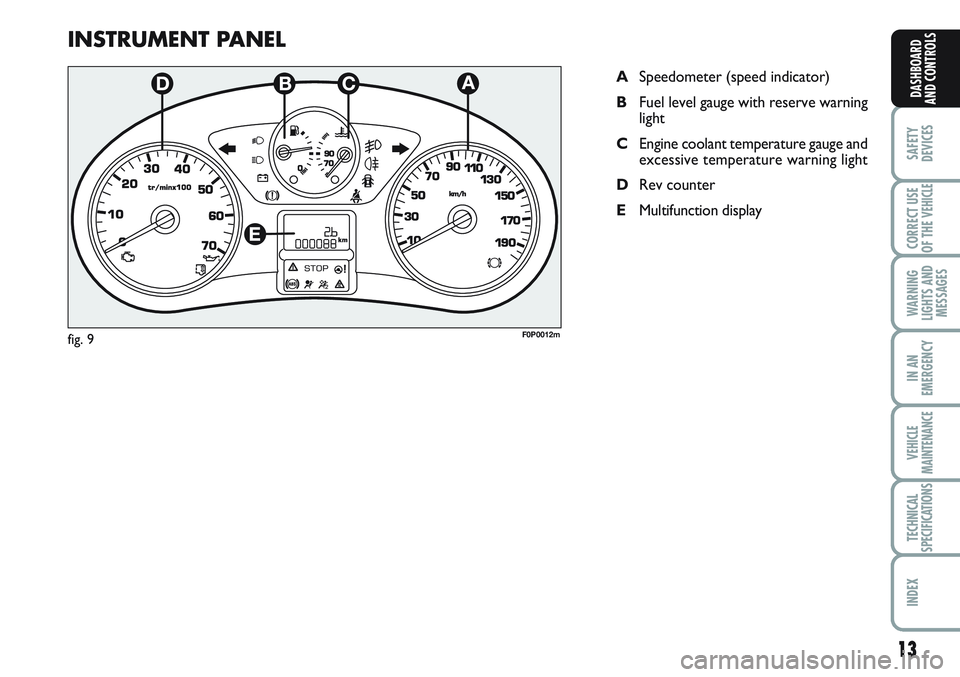
13
SAFETY
DEVICES
CORRECT USE
OF THE
VEHICLE
WARNING
LIGHTS AND
MESSAGES
IN AN
EMERGENCY
VEHICLE
MAINTENANCE
TECHNICAL
SPECIFICATIONS
INDEX
DASHBOARD
AND CONTROLS
INSTRUMENT PANEL
ASpeedometer (speed indicator)
BFuel level gauge with reserve warning
light
CEngine coolant temperature gauge and
excessive temperature warning light
DRev counter
EMultifunction display
F0P0012mfig. 9
Page 18 of 219
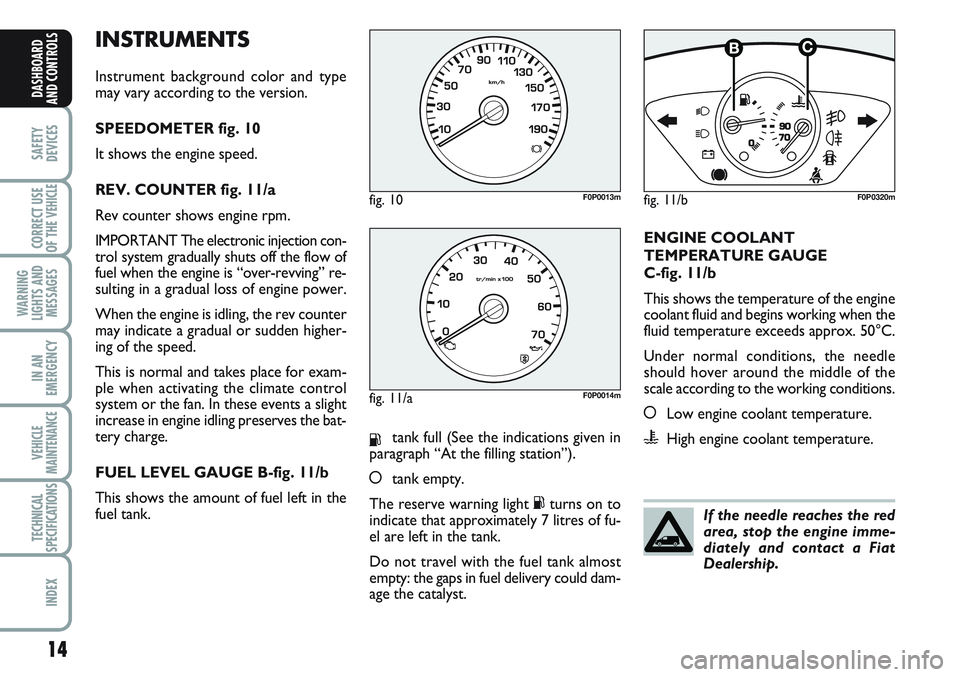
INSTRUMENTS
Instrument background color and type
may vary according to the version.
SPEEDOMETER fig. 10
It shows the engine speed.
REV. COUNTER fig. 11/a
Rev counter shows engine rpm.
IMPORTANT The electronic injection con-
trol system gradually shuts off the flow of
fuel when the engine is “over-revving” re-
sulting in a gradual loss of engine power.
When the engine is idling, the rev counter
may indicate a gradual or sudden higher-
ing of the speed.
This is normal and takes place for exam-
ple when activating the climate control
system or the fan. In these events a slight
increase in engine idling preserves the bat-
tery charge.
FUEL LEVEL GAUGE B-fig. 11/b
This shows the amount of fuel left in the
fuel tank.
Ktank full (See the indications given in
paragraph “At the filling station”).
åtank empty.
The reserve warning light Kturns on to
indicate that approximately 7 litres of fu-
el are left in the tank.
Do not travel with the fuel tank almost
empty: the gaps in fuel delivery could dam-
age the catalyst.ENGINE COOLANT
TEMPERATURE GAUGE
C-fig. 11/b
This shows the temperature of the engine
coolant fluid and begins working when the
fluid temperature exceeds approx. 50°C.
Under normal conditions, the needle
should hover around the middle of the
scale according to the working conditions.
åLow engine coolant temperature.uHigh engine coolant temperature.
fig. 10F0P0013m
14
SAFETY
DEVICES
CORRECT USE
OF THE
VEHICLE
WARNING
LIGHTS AND
MESSAGES
IN AN
EMERGENCY
VEHICLE
MAINTENANCE
TECHNICAL
SPECIFICATIONS
INDEX
DASHBOARD
AND CONTROLS
If the needle reaches the red
area, stop the engine imme-
diately and contact a Fiat
Dealership.
fig. 11/aF0P0014m
fig. 11/b
1/2
F0P0320m
Page 47 of 219
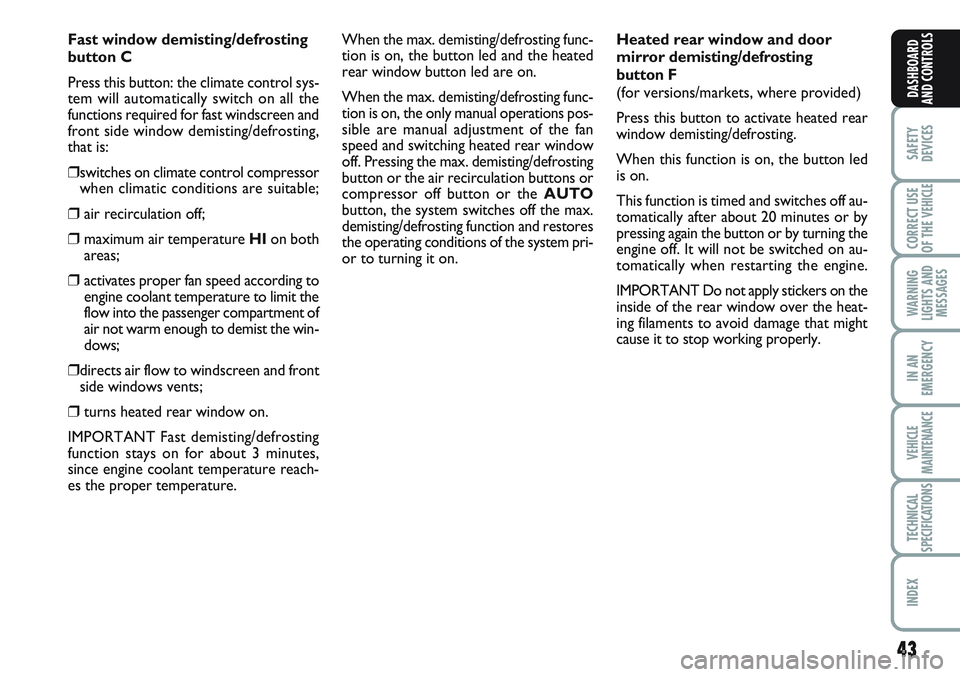
43
SAFETY
DEVICES
CORRECT USE
OF THE
VEHICLE
WARNING
LIGHTS AND
MESSAGES
IN AN
EMERGENCY
VEHICLE
MAINTENANCE
TECHNICAL
SPECIFICATIONS
INDEX
DASHBOARD
AND CONTROLS
Fast window demisting/defrosting
button C
Press this button: the climate control sys-
tem will automatically switch on all the
functions required for fast windscreen and
front side window demisting/defrosting,
that is:
❒switches on climate control compressor
when climatic conditions are suitable;
❒air recirculation off;
❒maximum air temperature HIon both
areas;
❒activates proper fan speed according to
engine coolant temperature to limit the
flow into the passenger compartment of
air not warm enough to demist the win-
dows;
❒directs air flow to windscreen and front
side windows vents;
❒turns heated rear window on.
IMPORTANT Fast demisting/defrosting
function stays on for about 3 minutes,
since engine coolant temperature reach-
es the proper temperature.When the max. demisting/defrosting func-
tion is on, the button led and the heated
rear window button led are on.
When the max. demisting/defrosting func-
tion is on, the only manual operations pos-
sible are manual adjustment of the fan
speed and switching heated rear window
off. Pressing the max. demisting/defrosting
button or the air recirculation buttons or
compressor off button or the AUTO
button, the system switches off the max.
demisting/defrosting function and restores
the operating conditions of the system pri-
or to turning it on.Heated rear window and door
mirror demisting/defrosting
button F
(for versions/markets, where provided)
Press this button to activate heated rear
window demisting/defrosting.
When this function is on, the button led
is on.
This function is timed and switches off au-
tomatically after about 20 minutes or by
pressing again the button or by turning the
engine off. It will not be switched on au-
tomatically when restarting the engine.
IMPORTANT Do not apply stickers on the
inside of the rear window over the heat-
ing filaments to avoid damage that might
cause it to stop working properly.
Page 48 of 219
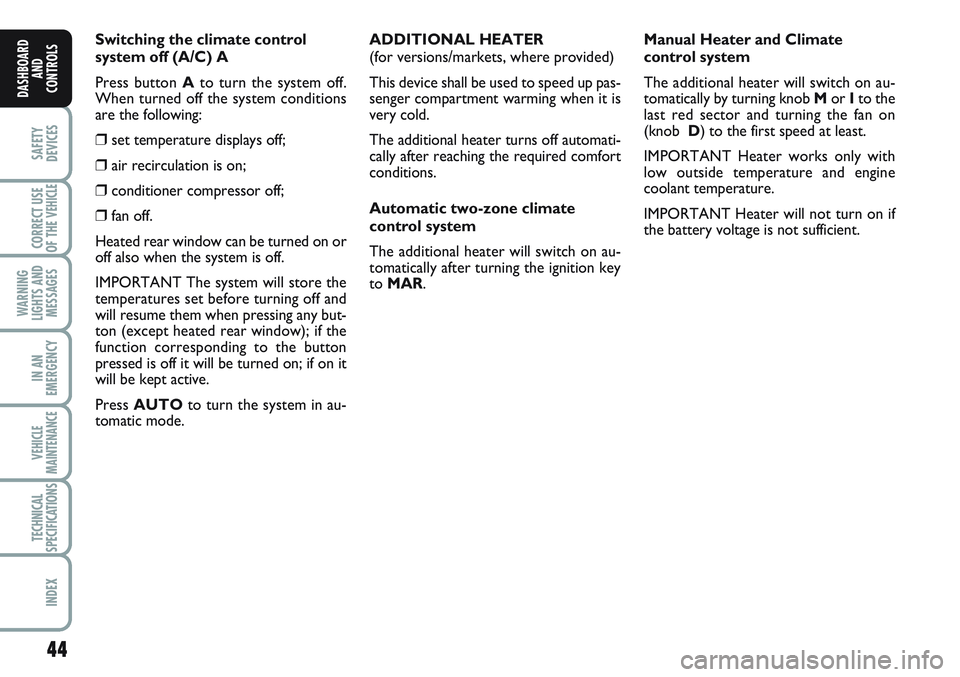
44
SAFETY
DEVICES
CORRECT USE
OF THE
VEHICLE
WARNING
LIGHTS AND
MESSAGES
IN AN
EMERGENCY
VEHICLE
MAINTENANCE
TECHNICAL
SPECIFICATIONS
INDEX
DASHBOARD
AND
CONTROLS
Switching the climate control
system off (A/C) A
Press button Ato turn the system off.
When turned off the system conditions
are the following:
❒set temperature displays off;
❒air recirculation is on;
❒conditioner compressor off;
❒fan off.
Heated rear window can be turned on or
off also when the system is off.
IMPORTANT The system will store the
temperatures set before turning off and
will resume them when pressing any but-
ton (except heated rear window); if the
function corresponding to the button
pressed is off it will be turned on; if on it
will be kept active.
Press AUTOto turn the system in au-
tomatic mode.ADDITIONAL HEATER
(for versions/markets, where provided)
This device shall be used to speed up pas-
senger compartment warming when it is
very cold.
The additional heater turns off automati-
cally after reaching the required comfort
conditions.
Automatic two-zone climate
control system
The additional heater will switch on au-
tomatically after turning the ignition key
to MAR.Manual Heater and Climate
control system
The additional heater will switch on au-
tomatically by turning knob M or Ito the
last red sector and turning the fan on
(knob D) to the first speed at least.
IMPORTANT Heater works only with
low outside temperature and engine
coolant temperature.
IMPORTANT Heater will not turn on if
the battery voltage is not sufficient.
Page 119 of 219
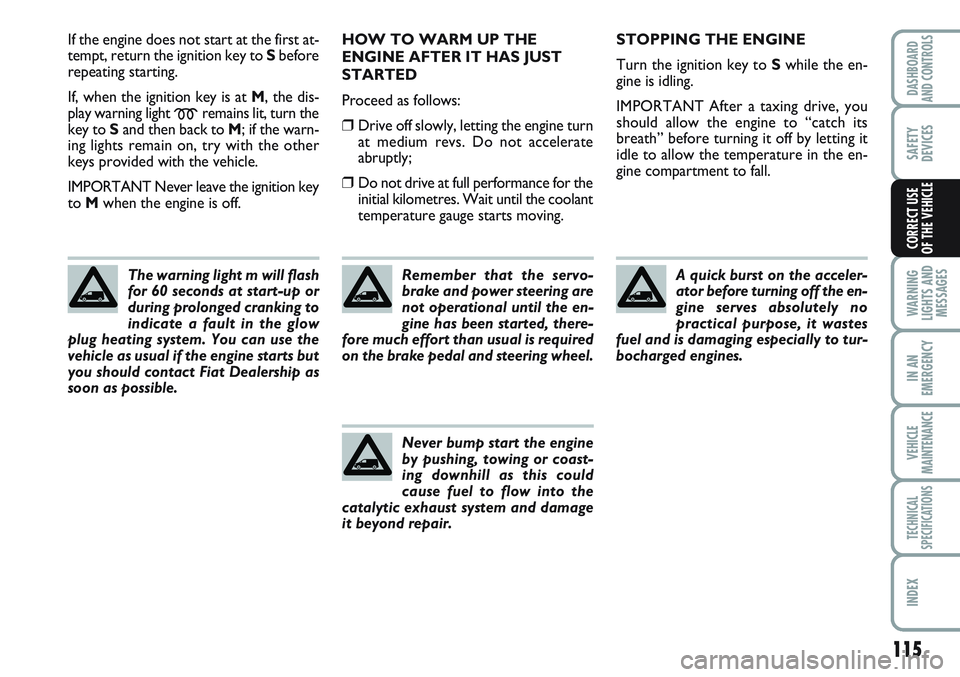
115
WARNING
LIGHTS AND
MESSAGES
IN AN
EMERGENCY
VEHICLE
MAINTENANCE
TECHNICAL
SPECIFICATIONS
INDEX
DASHBOARD
AND CONTROLS
SAFETY
DEVICES
CORRECT USE
OF THE VEHICLE
If the engine does not start at the first at-
tempt, return the ignition key to Sbefore
repeating starting.
If, when the ignition key is at M, the dis-
play warning light
mremains lit, turn the
key to Sand then back to M; if the warn-
ing lights remain on, try with the other
keys provided with the vehicle.
IMPORTANT Never leave the ignition key
to Mwhen the engine is off.
The warning light m will flash
for 60 seconds at start-up or
during prolonged cranking to
indicate a fault in the glow
plug heating system. You can use the
vehicle as usual if the engine starts but
you should contact Fiat Dealership as
soon as possible.
HOW TO WARM UP THE
ENGINE AFTER IT HAS JUST
STARTED
Proceed as follows:
❒Drive off slowly, letting the engine turn
at medium revs. Do not accelerate
abruptly;
❒Do not drive at full performance for the
initial kilometres. Wait until the coolant
temperature gauge starts moving.
Remember that the servo-
brake and power steering are
not operational until the en-
gine has been started, there-
fore much effort than usual is required
on the brake pedal and steering wheel.
Never bump start the engine
by pushing, towing or coast-
ing downhill as this could
cause fuel to flow into the
catalytic exhaust system and damage
it beyond repair.
STOPPING THE ENGINE
Turn the ignition key to Swhile the en-
gine is idling.
IMPORTANT After a taxing drive, you
should allow the engine to “catch its
breath” before turning it off by letting it
idle to allow the temperature in the en-
gine compartment to fall.
A quick burst on the acceler-
ator before turning off the en-
gine serves absolutely no
practical purpose, it wastes
fuel and is damaging especially to tur-
bocharged engines.
Page 127 of 219
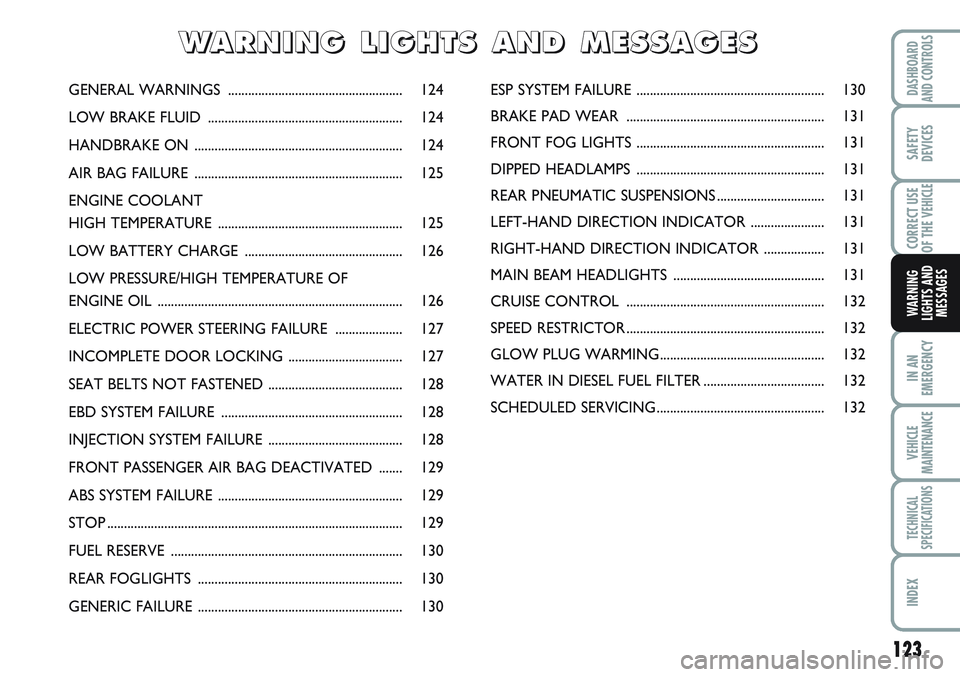
123
IN AN
EMERGENCY
VEHICLE
MAINTENANCE
TECHNICAL
SPECIFICATIONS
INDEX
DASHBOARD
AND CONTROLS
SAFETY
DEVICES
CORRECT USE
OF THE
VEHICLE
WARNING
LIGHTS AND
MESSAGES
GENERAL WARNINGS .................................................... 124
LOW BRAKE FLUID .......................................................... 124
HANDBRAKE ON .............................................................. 124
AIR BAG FAILURE .............................................................. 125
ENGINE COOLANT
HIGH TEMPERATURE ....................................................... 125
LOW BATTERY CHARGE ............................................... 126
LOW PRESSURE/HIGH TEMPERATURE OF
ENGINE OIL ......................................................................... 126
ELECTRIC POWER STEERING FAILURE .................... 127
INCOMPLETE DOOR LOCKING .................................. 127
SEAT BELTS NOT FASTENED ........................................ 128
EBD SYSTEM FAILURE ...................................................... 128
INJECTION SYSTEM FAILURE ........................................ 128
FRONT PASSENGER AIR BAG DEACTIVATED ....... 129
ABS SYSTEM FAILURE ....................................................... 129
STOP ........................................................................................ 129
FUEL RESERVE ..................................................................... 130
REAR FOGLIGHTS ............................................................. 130
GENERIC FAILURE ............................................................. 130ESP SYSTEM FAILURE ........................................................ 130
BRAKE PAD WEAR ........................................................... 131
FRONT FOG LIGHTS ........................................................ 131
DIPPED HEADLAMPS ........................................................ 131
REAR PNEUMATIC SUSPENSIONS ................................ 131
LEFT-HAND DIRECTION INDICATOR ...................... 131
RIGHT-HAND DIRECTION INDICATOR .................. 131
MAIN BEAM HEADLIGHTS ............................................. 131
CRUISE CONTROL ........................................................... 132
SPEED RESTRICTOR ........................................................... 132
GLOW PLUG WARMING................................................. 132
WATER IN DIESEL FUEL FILTER .................................... 132
SCHEDULED SERVICING.................................................. 132
W W
A A
R R
N N
I I
N N
G G
L L
I I
G G
H H
T T
S S
A A
N N
D D
M M
E E
S S
S S
A A
G G
E E
S S
Page 129 of 219
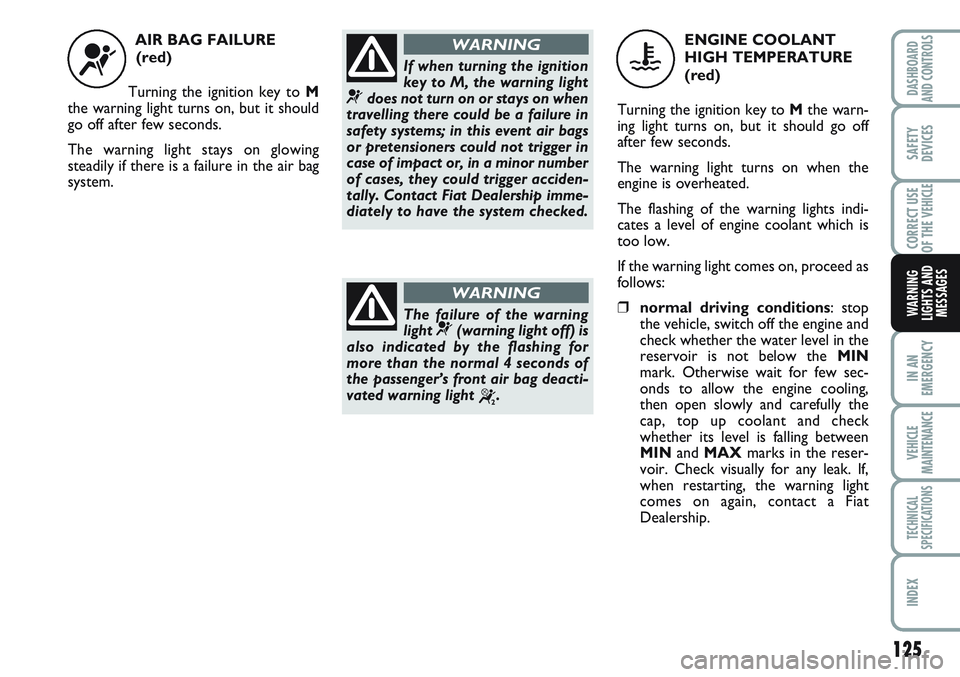
125
IN AN
EMERGENCY
VEHICLE
MAINTENANCE
TECHNICAL
SPECIFICATIONS
INDEX
DASHBOARD
AND CONTROLS
SAFETY
DEVICES
CORRECT USE
OF THE
VEHICLE
WARNING
LIGHTS AND
MESSAGES
AIR BAG FAILURE
(red)
Turning the ignition key to M
the warning light turns on, but it should
go off after few seconds.
The warning light stays on glowing
steadily if there is a failure in the air bag
system.
¬If when turning the ignition
key to M, the warning light
¬does not turn on or stays on when
travelling there could be a failure in
safety systems; in this event air bags
or pretensioners could not trigger in
case of impact or, in a minor number
of cases, they could trigger acciden-
tally. Contact Fiat Dealership imme-
diately to have the system checked.
WARNING
The failure of the warning
light ¬(warning light off) is
also indicated by the flashing for
more than the normal 4 seconds of
the passenger’s front air bag deacti-
vated warning light
“.
WARNING
ENGINE COOLANT
HIGH TEMPERATURE
(red)
Turning the ignition key to Mthe warn-
ing light turns on, but it should go off
after few seconds.
The warning light turns on when the
engine is overheated.
The flashing of the warning lights indi-
cates a level of engine coolant which is
too low.
If the warning light comes on, proceed as
follows:
❒normal driving conditions: stop
the vehicle, switch off the engine and
check whether the water level in the
reservoir is not below the MIN
mark. Otherwise wait for few sec-
onds to allow the engine cooling,
then open slowly and carefully the
cap, top up coolant and check
whether its level is falling between
MINand MAXmarks in the reser-
voir. Check visually for any leak. If,
when restarting, the warning light
comes on again, contact a Fiat
Dealership.
u
Page 130 of 219
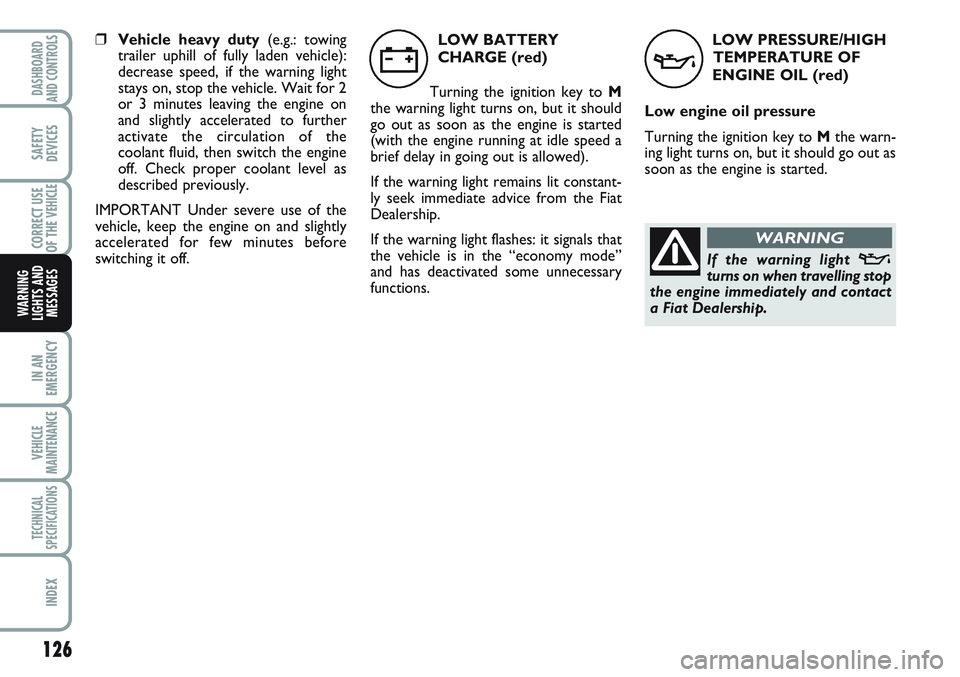
126
IN AN
EMERGENCY
VEHICLE
MAINTENANCE
TECHNICAL
SPECIFICATIONS
INDEX
DASHBOARD
AND CONTROLS
SAFETY
DEVICES
CORRECT USE
OF THE
VEHICLE
WARNING
LIGHTS AND
MESSAGES
LOW PRESSURE/HIGH
TEMPERATURE OF
ENGINE OIL (red)
Low engine oil pressure
Turning the ignition key to Mthe warn-
ing light turns on, but it should go out as
soon as the engine is started.
v
If the warning light vturns on when travelling stop
the engine immediately and contact
a Fiat Dealership.
WARNING
❒Vehicle heavy duty(e.g.: towing
trailer uphill of fully laden vehicle):
decrease speed, if the warning light
stays on, stop the vehicle. Wait for 2
or 3 minutes leaving the engine on
and slightly accelerated to further
activate the circulation of the
coolant fluid, then switch the engine
off. Check proper coolant level as
described previously.
IMPORTANT Under severe use of the
vehicle, keep the engine on and slightly
accelerated for few minutes before
switching it off.LOW BATTERY
CHARGE (red)
Turning the ignition key to M
the warning light turns on, but it should
go out as soon as the engine is started
(with the engine running at idle speed a
brief delay in going out is allowed).
If the warning light remains lit constant-
ly seek immediate advice from the Fiat
Dealership.
If the warning light flashes: it signals that
the vehicle is in the “economy mode”
and has deactivated some unnecessary
functions.
w
Page 160 of 219
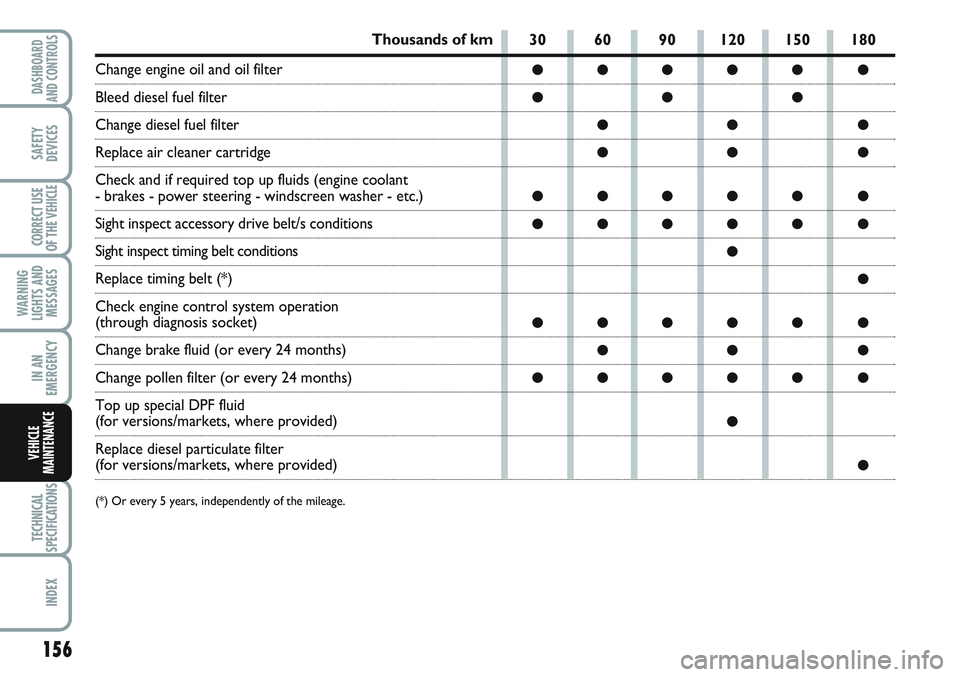
156
WARNING
LIGHTS AND
MESSAGES
TECHNICAL
SPECIFICATIONS
INDEX
DASHBOARD
AND CONTROLS
SAFETY
DEVICES
CORRECT USE
OF THE
VEHICLE
IN AN
EMERGENCY
VEHICLE
MAINTENANCE
30 60 90 120 150 180
●●●●● ●
●●●
●● ●
●● ●
●●●●● ●
●●●●● ●
●
●
●●●●● ●
●● ●
●●●●● ●
●
●
Thousands of km
Change engine oil and oil filter
Bleed diesel fuel filter
Change diesel fuel filter
Replace air cleaner cartridge
Check and if required top up fluids (engine coolant
- brakes - power steering - windscreen washer - etc.)
Sight inspect accessory drive belt/s conditions
Sight inspect timing belt conditions
Replace timing belt (*)
Check engine control system operation
(through diagnosis socket)
Change brake fluid (or every 24 months)
Change pollen filter (or every 24 months)
Top up special DPF fluid
(for versions/markets, where provided)
Replace diesel particulate filter
(for versions/markets, where provided)
(*) Or every 5 years, independently of the mileage.
Page 161 of 219
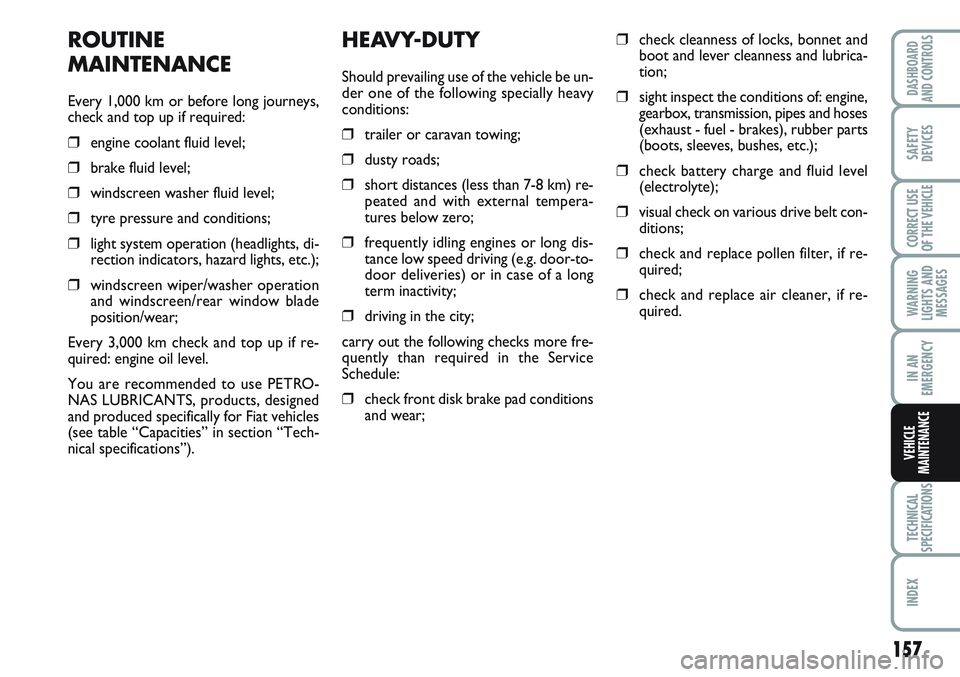
157
WARNING
LIGHTS AND
MESSAGES
TECHNICAL
SPECIFICATIONS
INDEX
DASHBOARD
AND CONTROLS
SAFETY
DEVICES
CORRECT USE
OF THE
VEHICLE
IN AN
EMERGENCY
VEHICLE
MAINTENANCE
HEAVY-DUTY
Should prevailing use of the vehicle be un-
der one of the following specially heavy
conditions:
❒trailer or caravan towing;
❒dusty roads;
❒short distances (less than 7-8 km) re-
peated and with external tempera-
tures below zero;
❒frequently idling engines or long dis-
tance low speed driving (e.g. door-to-
door deliveries) or in case of a long
term inactivity;
❒driving in the city;
carry out the following checks more fre-
quently than required in the Service
Schedule:
❒check front disk brake pad conditions
and wear;
❒check cleanness of locks, bonnet and
boot and lever cleanness and lubrica-
tion;
❒sight inspect the conditions of: engine,
gearbox, transmission, pipes and hoses
(exhaust - fuel - brakes), rubber parts
(boots, sleeves, bushes, etc.);
❒check battery charge and fluid level
(electrolyte);
❒visual check on various drive belt con-
ditions;
❒check and replace pollen filter, if re-
quired;
❒check and replace air cleaner, if re-
quired.
ROUTINE
MAINTENANCE
Every 1,000 km or before long journeys,
check and top up if required:
❒engine coolant fluid level;
❒brake fluid level;
❒windscreen washer fluid level;
❒tyre pressure and conditions;
❒light system operation (headlights, di-
rection indicators, hazard lights, etc.);
❒windscreen wiper/washer operation
and windscreen/rear window blade
position/wear;
Every 3,000 km check and top up if re-
quired: engine oil level.
You are recommended to use PETRO-
NAS LUBRICANTS, products, designed
and produced specifically for Fiat vehicles
(see table “Capacities” in section “Tech-
nical specifications”).